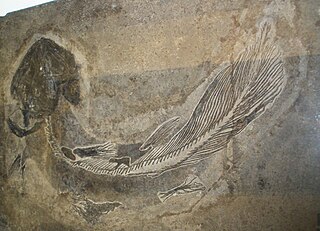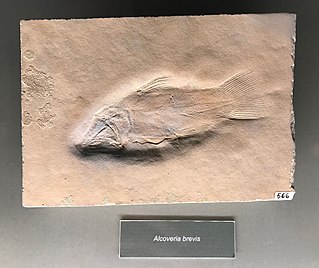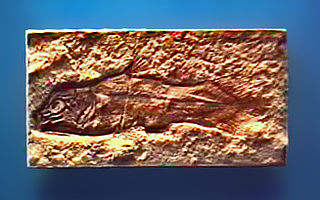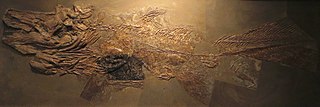
Coelacanths are an ancient group of lobe-finned fish (Sarcopterygii) in the class Actinistia. As sarcopterygians, they are more closely related to lungfish and tetrapods than to ray-finned fish.

Chinlea is an extinct genus of late Triassic Mawsoniid coelacanth fish found in and named after the Chinle Formation that crops out in the southwestern states of Arizona and New Mexico. The word “Chinle” comes from the Navajo word meaning "flowing out", referencing the location where water flows out of the Canyon de Chelly. They were also possibly found in the Dockum Group.

Latimeriidae is the only extant family of coelacanths, an ancient lineage of lobe-finned fish. It contains two extant species in the genus Latimeria, found in deep waters off the coasts of southern Africa and east-central Indonesia. In addition, several fossil genera are known from the Mesozoic of Europe, the Middle East, and the southeastern United States, dating back to the Triassic.

Coelacanthus is a genus of extinct coelacanths that first appeared during the Permian period. It was the first genus of coelacanths described, about a century before the discovery of the extant coelacanth Latimeria. The order Coelacanthiformes is named after it.

The Indonesian coelacanth, also called Sulawesi coelacanth, is one of two living species of coelacanth, identifiable by its brown color. It is listed as vulnerable by the IUCN, while the other species, L. chalumnae is listed as critically endangered. Separate populations of the Indonesian coelacanth are found in the waters of north Sulawesi as well as Papua and West Papua.

Axelrodichthys is an extinct genus of mawsoniid coelacanth from the Cretaceous of Africa, North and South America, and Europe. Several species are known, the remains of which were discovered in the Lower Cretaceous (Aptian-Albian) of Brazil, North Africa, and possibly Mexico, as well as in the Upper Cretaceous of Morocco (Cenomanian), Madagascar and France. The Axelrodichthys of the Lower Cretaceous frequented both brackish and coastal marine waters while the most recent species lived exclusively in fresh waters. The French specimens are the last known fresh water coelacanths. Most of the species of this genus reached 1 metre to 2 metres in length. Axelrodichthys was named in 1986 by John G. Maisey in honor of the American ichthyologist Herbert R. Axelrod.
Laugia is an extinct genus of coelacanth fish which lived during the Induan age of the Early Triassic epoch in what is now Greenland. The type and only species, Laugia groenlandica, was collected from the Wordie Creek Formation and described by Erik Stensiö. The genus is named after Lauge Koch.

Mawsonia is an extinct genus of prehistoric coelacanth fish. It is amongst the largest of all coelacanths, with one quadrate specimen possibly belonging to an individual measuring 5.3 metres in length. It lived in freshwater and brackish environments from the late Jurassic to the mid-Cretaceous of South America, eastern North America, and Africa. Mawsonia was first described by British paleontologist Arthur Smith Woodward in 1907.

Holophagus is an extinct genus of coelacanth belonging to Latimeriidae. The type species, Holophagus gulo, is known from the Lower Jurassic marine Lias of England. Some authors have considered the genus restricted to the Lias of England.

Alcoveria is an extinct genus of mawsoniid coelacanth fish which lived during the Triassic period. Alcoveria is known from a well preserved specimen from Spain. It lived in a marine environment.
Changxingia is a genus of prehistoric lobe-finned fish that belonged to the coelacanth family Mawsoniidae. It lived during the Late Permian in Zhejiang, southern China. It contains two species, C. aspiratilis and C. weii, which were named in 1981 and 1997 from specimens found at the same locality. They are the first Permian marine coelacanths found in Asia.

Mawsoniidae is an extinct family of prehistoric coelacanth fishes which lived during the Triassic to Cretaceous periods. Members of the family are distinguished from their sister group, the Latimeriidae by the presence of ossified ribs, a coarse rugose texture on the dermatocranium and cheek bones, the absence of the suboperculum and the spiracular, and reduction or loss of the descending process of the supratemporal. Mawsoniids are known from North America, Europe, South America, Africa, Madagascar and Asia. Unlike Latimeriidae, which are exclusively marine, Mawsoniidae were also native to freshwater and brackish environments. Mawsoniids represent among the youngest known coelacanths, with the youngest known remains of the freshwater genus Axelrodichthys from France and an indeterminate marine species from Morocco being from the final stage of the Cretaceous, the Maastrichtian, roughly equivalent in age to the youngest known fossils of latimeriids. Species of Mawsonia and Trachymetopon are known to have exceeded 5 metres in length, making them among the largest known bony fish to have ever existed.

Laugiidae is an extinct family of prehistoric lobe-finned fishes which lived during the Triassic and Jurassic periods. Their fossils has been found in Canada, China, Germany and Greenland.

Mylacanthus is an extinct genus of prehistoric coelacanth lobe-finned fish that lived during the Smithian age of the Early Triassic epoch in what is now Svalbard.

Trachymetopon is an extinct genus of prehistoric coelacanth from the Jurassic of Europe. Fossils have been found in the Early Jurassic Posidonia Shale of Germany the Middle Jurassic Marnes de Dives of France, and probably the Late Jurassic Kimmeridge Clay of England. Only one species has been named, Trachymetopon liassicum, described by Henning in 1951 from an almost complete specimen found in the Lower Toarcian of Ohmden in Baden-Württemberg. Another specimen is known from the same site, and two older specimens come from the Sinemurian of Holzmaden. The holotype of this species is 1.6 metres in length. A giant specimen of an undetermined species of Trachymetopon found at the Middle Jurassic Falaises des Vaches Noires of Normandy. This specimen, composed of a 53 cm long palatoquadrate, belongs to an individual 4 metres (13 ft) in length. A basisphenoid found in a museum in Switzerland that likely originates from the same locaity probably belonged to an individual around 5 m (16 ft) long, making Trachymetopon the largest of all coelacanths alongside Mawsonia. A study published in 2015 revealed that this coelacanth belongs to the Mawsoniidae. Trachymetopon is one of the few known mawsoniids to have been exclusively marine, while most of the other members of the group have lived in fresh and brackish waters.
Scleracanthus is an extinct genus of prehistoric coelacanth lobe-finned fish. It lived during the Early Triassic epoch in what is now Spitsbergen, Svalbard.
This list of fossil fishes described in 2013 is a list of new taxa of placoderms, fossil cartilaginous fishes and bony fishess of every kind that have been described during the year 2013. The list only includes taxa at the level of genus or species.

Megalocoelacanthus dobiei is an extinct species of giant latimeriid coelacanth lobe-finned fish which lived during the Lower Campanian epoch until possibly the early Maastrichtian in the Late Cretaceous period in Appalachia, the Western Interior Seaway and Mississippi Embayment. Its disarticulated remains have been recovered from the Eutaw Formation, Mooreville Chalk Formation, and Blufftown Formation of Alabama, Mississippi, and Georgia, and also from the Niobrara Formation of Kansas. Although no complete skeleton is known, careful examination of skeletal elements demonstrate it is closely related to the Jurassic-aged coelacanthid Libys. The species is named for herpetologist James L. Dobie. It has been estimated to have been 3.5—4.5 meters in length.

Parnaibaia is a genus of coelacanth fish which lived during the Late Jurassic period. Fossils of Parnaibaia have been found in the Pastos Bons Formation in Maranhão, Brazil. Parnaibaia was described for the first time by palaeontologist Yoshitaka Yabumoto in 2008.

Foreyia is an extinct genus of coelacanth lobe-finned fish which lived during the Middle Triassic period in what is now Canton of Graubünden, Switzerland. It contains a single species F. maxkuhni.



















